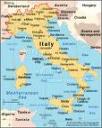history of Italy
Posted by countrieshistory on March 9, 2007
History of Italy
United in 1861, Italy has significantly contributed to the cultural and social development of the entire Mediterranean area, deeply influencing European culture as well. Important cultures and civilizations have existed there since prehistoric times.
After Magna Graecia, the Etruscan civilization and especially the Roman Republic and Empire that dominated this part of the world for many centuries came an Italy whose people would make immeasurable contributions to the development of European philosophy, science, and art during the Middle Ages and the Renaissance. Dominated by city-states for much of the medieval and Renaissance period, the Italian peninsula was eventually unified amidst much struggle in the 19th and 20th centuries.
Origins of the name
The name Italy (Italia) is an ancient name for the country and people of Southern Italy. Its origin is unclear, but could be Greek for “Land of Cattle Calves or Veal”. Coins bearing the name Italia were minted by an alliance of Italic tribes (Sabines, Samnites, Umbrians and other) competing with Rome in the first century B.C. By the time of emperor Augustus approximately, the multi-ethnic territory of Italy was included in Italia as the central unit of the Empire; Cisalpine Gaul, the Upper Po valley, for example, was appended in 42 BC. After the fall of the Western Roman Empire and the Lombard invasions, “Italy” or “Italian” gradually became the collective name for diverse states appearing on the peninsula and their overseas properties. Pallotino claims that the name was originally derived from the Itali settled in modern Calabria. The Greeks gradually came to use the name for a greater region, but it was not until the time of the Roman conquests that the term was expanded to cover the entire peninsula (Pallotino, M., History of Earliest Italy, trans. Ryle, M & Soper, K. in Jerome Lectures, Seventeenth Series, p.50).
Bronze Age (15th to 8th c. BC)
Terramare culture takes its name from the black earth (terremare) residue of settlement mounds, which have long served the fertilizing needs of local farmers. The occupations of the terramare people as compared with their Neolithic predecessors may be inferred with comparative certainty. They were still hunters, but had domesticated animals; they were fairly skilful metallurgists, casting bronze in moulds of stone and clay, and they were also agriculturists, cultivating beans, the vine, wheat and flax. It is thought the Terremare culture may be an early manifestation of Italic-speaking Indo-Europeans.
Iron Age (8th to 5th c BC)
Main article: Ancient Italic peoples
Languages in Iron Age Italy, 6th century BC.
Villanovan culture brought iron-working to the Italian peninsula; Villanovans practiced cremation and buried the ashes of their dead in pottery urns of distinctive double-cone shape. Generally speaking, Villanovan settlements were centered in the Po River valley and Etruria round Bologna, later an important Etruscan center, and areas in Emilia Romagna (at Verruchio and Fermi), in Tuscany and Lazio. Further south, in Campania, a region where inhumation was the general practice, Villanovan cremation burials have been identified at Capua, at the “princely tombs” of Pontecagnano near Salerno (finds conserved in the Museum of Agro Picentino) and at Sala Consilina.

Leave a comment